The ASUS ZenPad S (Z580CA) Review
by Brandon Chester on August 31, 2015 8:00 AM ESTDisplay: Stock Settings
I often say that a smartphone is just a display you interact with, which makes the need for a high quality screen paramount. This is even more true for tablets, which are quite literally large touchscreen displays that the user interacts with. With tablet displays having peaked in terms of resolution for the time being, manufacturers are now turning their attention toward color accuracy. Flagship devices like Samsung's Galaxy Tab S tablets and Apple's full sized iPads feature displays with an exceptional level of color accuracy, while smaller or less expensive tablets are more hit-and-miss.
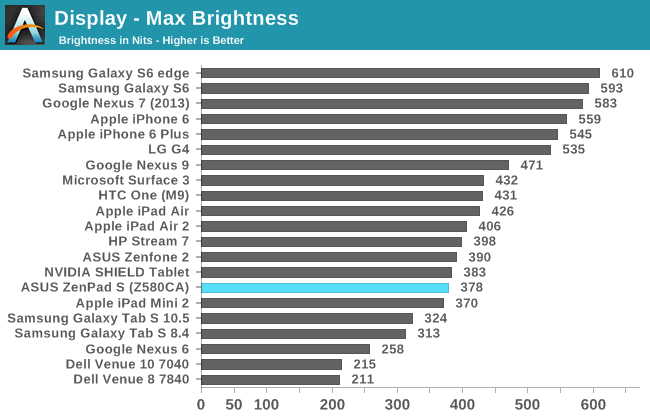

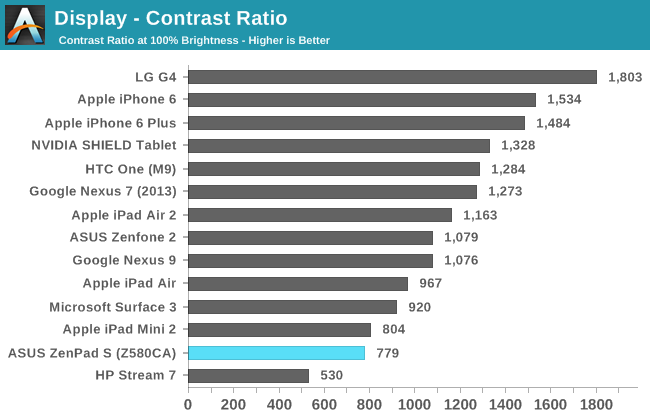
Unsurprisingly, the ZenPad's display is very similar to that of the iPad Mini 2 as far as brightness, black level, and contrast are concerned. While Apple has decided to round 7.85" to 7.9", and ASUS has decided to round to 8.0", I'm fairly confident both devices are using the same LCD technology with different backlight arrays. It should be noted that while the contrast ratio is similar in our measurements, when there is ambient light there will be a much more significant drop in contrast on the iPad Mini 2 due to its unlaminated display.
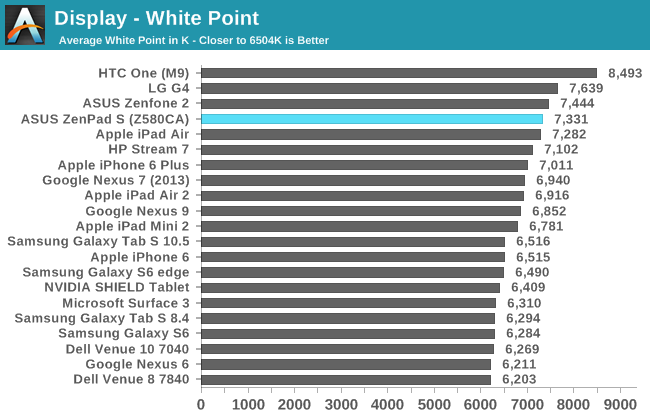
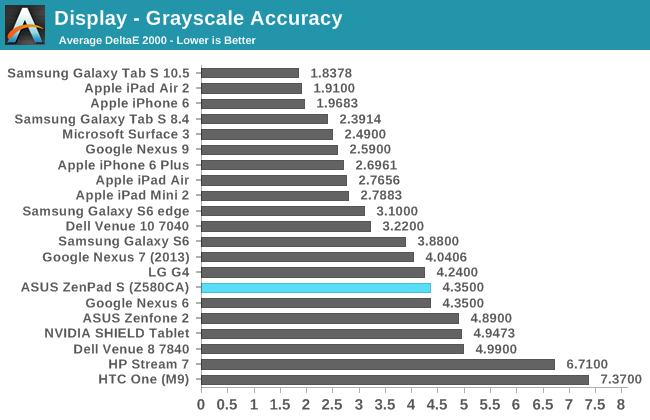
Even if two devices use the same display panel, the color characteristics of each can vary significantly depending on the level of calibration, as well as the spectral range of the LED backlight used. Apple’s iPad Mini 2 achieves a level of greyscale accuracy where errors can only be seen in static content, and is good enough for editing photos and videos without concerns about the accuracy of the images. The ZenPad S doesn’t do as well, with a significant blue shift to most shades of grey. This is also reflected in the display’s high average white point of 7331K. While the ZenPad S doesn’t cost as much as an iPad Air 2 or a Galaxy Tab S2, the Z580CA’s price of $299 is exactly the same as the iPad Mini 2. With that in mind, it’s concerning to see such a gap between the greyscale performance of the ZenPad S and the iPad Mini 2.
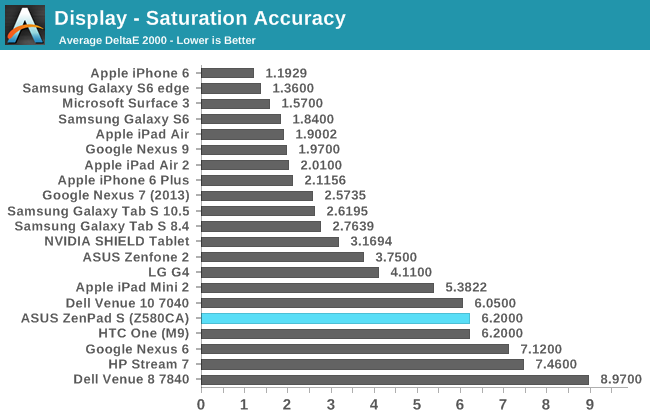
Saturation accuracy on the ZenPad S is much lower than what could be achieved with more attention paid to the display’s calibration. With a DeltaE average of 6.2, the ZenPad S is actually less accurate with rendering primary and secondary colors than the iPad Mini 2, despite the latter having a backlight array that only allows for narrow coverage of the blue and red parts of the sRGB gamut. The spectral range of the LEDs in the ZenPad S almost covers the entire sRGB gamut, but the panel undershoots significantly with reds, overshoots with blue beyond 60% saturation, and has various levels of inaccuracy with yellow, cyan, and most of all, magenta. I was really excited to see that the ZenPad S doesn’t suffer from the narrow gamut of the iPad Mini 2, but I was let down when I realized that the accuracy of primary and secondary colors was actually worse than the iPad due to inadequate calibration.
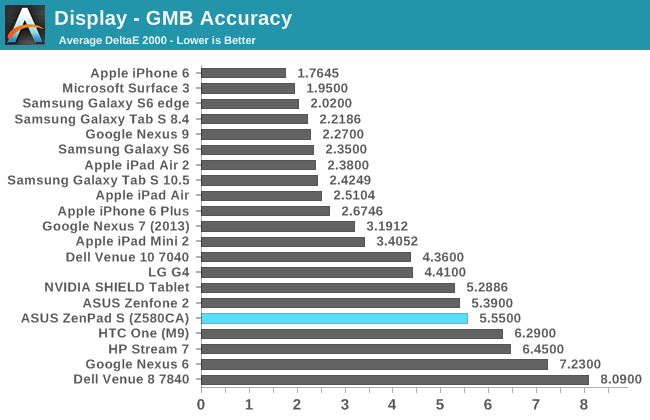
Accurately reproducing color mixtures requires a reasonably accurate gamma, RGB balance for grey shades, and accurate saturations. Gamma on the ZenPad S is reasonably accurate for a mobile device, but the way the display tends toward blue coupled with the inaccurate saturations results in inaccurate color mixtures as well. The ZenPad’s average DeltaE of 5.55 doesn’t compare favorably with the iPad Mini 2’s DeltaE of 3.4 which is imperfect but still fairly accurate. The reason that the iPad Mini 2 ends up being more accurate is because while it cannot be accurate outside its native gamut, within the section of sRGB that it does cover it is very accurate.
As far as the default display configuration of the ZenPad S goes, I’m not exactly thrilled. While it does have a wider gamut than the iPad Mini 3, it ends up being less accurate in every respect due to issues with rendering primary and secondary colors, and a blue shift in the greyscale. Surprisingly, the ZenPad S having a fully laminated display has done nothing to reduce black levels and increase contrast ratio when compared to the non-laminated iPad Mini 2 display, which is an additional disappointment. However, ASUS does provide a few settings to tweak the display, and so hope is not lost.


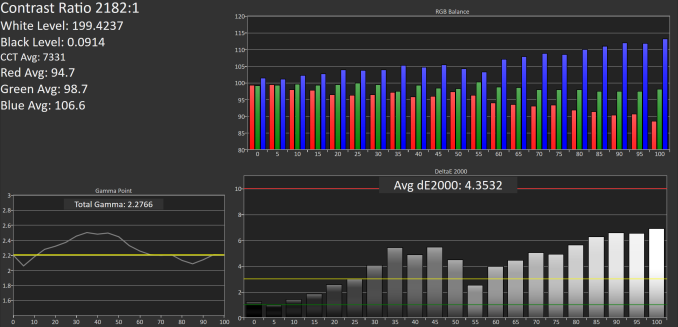

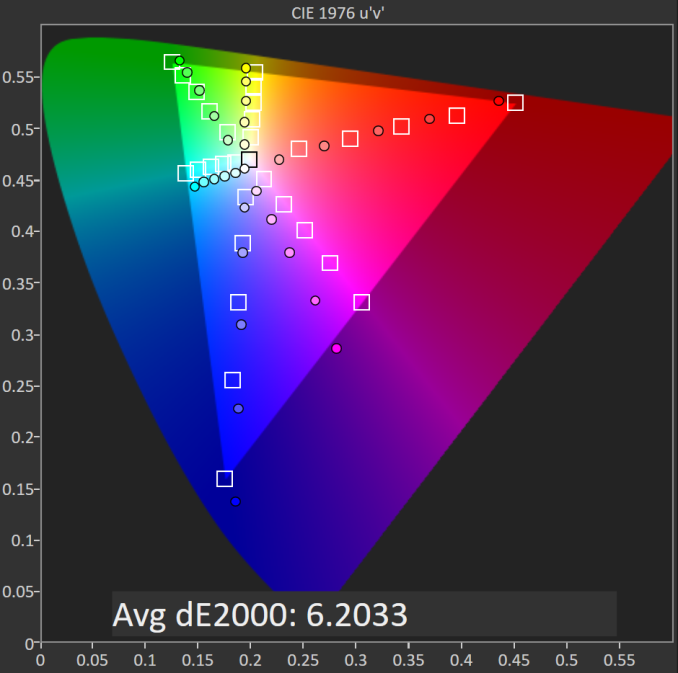









114 Comments
View All Comments
DanNeely - Tuesday, September 1, 2015 - link
They get enough loaners to keep the review queue in a constant backlog (see periodic comment rage about the review of X, Y, and Z being delayed). If ad revenue ever got to the point that they could hire enough reviewers that they didn't have anything to review at times a shopping trip might make sense; but they don't and probably never will.Even if that did happen, Sony probably wouldn't be the recipient because they've almost entirely abandoned the US market. If you're bound and determined to have one you can get it; but for 99% of the consumers who read the articles and let the ads load (aka the people who actually make the site money) Sony is irrelevant because it's not something they can find in the store.
MrSavage - Tuesday, September 1, 2015 - link
Interesting Dan. Thanks for the insight!Michael REMY - Thursday, September 3, 2015 - link
well, i can believe what i read. you wait for the brand to provide you the device that you review. it is a leak of independence, don't you think ? can't you just buy it on amazon, try it, write your review then get your refund and return the product ?Seriously, for your own knoewledge, you should have test for yourself the last model of sony tablet to win&earn another point of view (better) on samsung tablet or asus zenPad.
IanHagen - Wednesday, September 2, 2015 - link
I'm really glad 4:3 aspect ratio won the battle. It's so much more useful in a tablet.911electronic - Wednesday, September 2, 2015 - link
Nice specification but still i dont know what about battery. It is important for most of the users.DanNeely - Wednesday, September 2, 2015 - link
Page 8 Battery Life and Charge Time. 7 hours on the wifi browsing test is a very poor result.aldenf - Friday, September 4, 2015 - link
Maybe I need to turn in my geek card. I see no benefit whatsoever of such resolutions in an 8" form-factor. The way I use tablets, I prefer the 4:3 ratio. So this is great. I spend far too many hours sitting 30" from my 24" 19x12 IPS, calibrated with a ColorMunki, working in Photoshop and Premiere. With an 8" display, at an 18" distance, I see no benefit above 1280x1024. On the contrary; brightness, performance and battery life suffer significantly. I've used most of what is currently available on the market and don't get the insistence of pushing higher resolutions at 8". I own two 8" tablets; an 800x600 Android and 1024x768 iPad Mini. 800x600 is borderline rough but 1024x768 is pretty good. 1280x1024 seems ideal. Why do we suck up all the marketing baloney? Bigger isn't always better. More isn't always more. It's not the resolution that we discern as better, it's simply that they're usually higher quality displays. Drop the Asus' resolution to 1280x1024, keep the high quality, do a reasonable calibration from the factory, drop the price to $250 and you have a darned nice Android tablet to last a couple of years. Really, what more do we want?nitram_tpr - Wednesday, September 9, 2015 - link
Another vote for widescreen tablets for me, it is all I've ever used (still using a transformer prime). I do watch a lot of medie on my device while I'm travelling / commuting. I tried it on the wife's iPad and got fed up with the huge black bars. Full screening it is like watching an old CRT, so I'm glad there are still the widescreen options out there.To all the people whining and bitching about this tablet, are you actually pissed off because you wanted to buy it, or are you just joining in with the bitch fest?
If it isn't 4:3 don't buy it, end of.
er0k - Monday, September 28, 2015 - link
Hello: My Zenpad 8.0 S is only two days old, out of the box. I cannot seem to charge it. I charged it for many hours yesterday only to find it with a dead battery. I moved it to several different outlets, tried different cables and chargers that work with other devices and worked with it previously, to no avail. It will show the battery charging icon, but does not appear to actually charge. Any ideas? Thanks.System Optimizer - Wednesday, November 4, 2015 - link
er0k,Did you ever get your charging issue solved. Did you try connecting to charge off a computer (if you have USB ports that charge, and the appropriate wire)? Did you hold in the power button and one of the volume buttons to force a reset on the device? (I have an old Archos 80 Titanium tablet, and once I thought it wasn't charging, and was dead, but in reality it was charged and was reporting improper information and the forced reboot resolved the issue). I don't know the z580's reset process, but I expect its something similar.